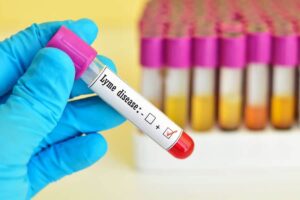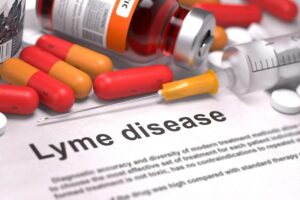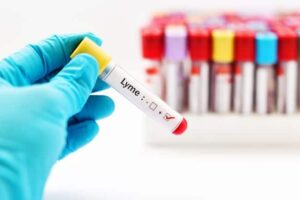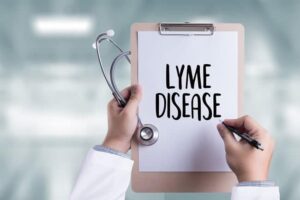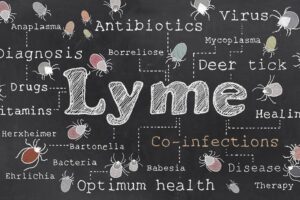Join Dr. Minkoff from LifeWorks Wellness Center in Clearwater, Florida as he sheds light on Lyme disease, its prevalence, and the misconceptions surrounding it.
In this informative video, Dr. Minkoff discusses the history of Lyme disease, its transmission through insect bites, and the various symptoms it can manifest.
He also emphasizes the importance of accurate diagnosis and shares insights into effective treatments, including ozone therapy and biofilm disruption.
Don’t miss this eye-opening discussion that offers hope and healing for those affected by Lyme disease.
Visit LifeWorks Wellness Center for expert guidance and personalized care.
If you would like to schedule an appointment, please call (727) 466-6789.
Demystifying Lyme Disease Video
Watch now to learn more about effective Lyme disease treatments.

Hi, Dr Minkoff, LifeWorks Wellness Center, Clearwater, Florida.
I want to talk to you about Lyme disease.
Now Lyme disease, according to some people doesn’t even exist. I want to tell you it does exist, it is real. In fact Lyme disease has been around since the Egyptian mummies.
They find borrelia burgdorferi, the agent of Lyme disease in preserved Egyptian mummies, so that’s probably a thousand BC so 3000 some years ago.
So this organism is around.
Infectious diseases tend to cycle.
When I was growing up, everyone, all the little kids got strep and we all had our tonsils out because we all got strep and by the time you were two or three or four years old you had your tonsils out.
If you do the generate, my generation we had them out.
People hardly ever remove tonsils now because strep is just on the wain, like it’s not around.
Lyme disease is now in a boom phase and it’s worldwide and it’s in every state and it’s in every country.
And when we say Lyme disease what we mean is that this is an infection that is transmitted by an insect bite.
Traditionally that insect was a deer tick and the disease was described probably 30 years ago by a microbiologist in Connecticut in Lyme, Connecticut where young age people were getting symptom complexes after a tick bite with arthritis and neurological symptoms and fatigue and autoimmune symptoms.
And he did an aspiration on a knee that was inflamed and he got this bacteria out of it and he named it after himself, which was borrelia.
Borrelia is a class of bacteria that look like little spirals. Burgdorferi which was his last name, his name was Willie Burgdorferi, so that’s where it came from in the modern day age.
Now what we know now is it’s not just ticks. That biting insects of any kind can transfer it. Mosquitoes I think are very common.
So that insect bit something that had Lyme in its bloodstream, it got in that insects mouth, it lived there, that insect then bit you and these insects need blood to live and so it sucked your blood and in the meantime some of the bacteria or organisms that were in its mouth got in your body.
That can produce a local infection in you or a local inflammatory reaction.
Again classically you get a bullseye rash, so that’s a rash that’s got a clear center and a red outside.
In our experience these days less than one percent of people get a bullseye rash after a tick bite.
Now some of these ticks are really small and you, they’re like pieces of pepper, you can hardly even see them.
So not every tick has Lyme, not every tick bite results in Lyme.
Lots of people get bit by mosquitoes and I think that results in Lyme.
But there’s enough bacteria in that ticks mouth or mosquito’s mouth to get these infectious organisms into your bloodstream.
Now at that point you may have a flu syndrome, a mild fever, some joint pain and the thing has actually infected you and at that point if you took an antibiotic for a couple of weeks, you’d end it.
And that’s a reasonable treatment. In the tick’s mouth there are multiple organisms and we classically now find that there’s about 8 or 10 of these different kinds of bacteria, not just the spirochete, not just the borrelia but Rocky Mountain spotted fever organism.
Amoeba called babesia, another bacteria called Bartonella, another spirochete called spirochita, like these things are common and they sort of go as a pack.
When these organisms get into your body, if they produce an immune reaction you may be able to find that the body has made proteins against them, antibodies, where if you do a traditional blood test at Labcorp or Quest of a western blot, you have antibodies and they say yeah you got Lyme disease.
Unfortunately most of the time, these organisms are very in your bloodstream for very short periods of time, they may end up in your brain, they may end up in your liver, they may end up in your skin, they end up in other places where antibodies are not produced.
And so when you do the test for Lyme disease you don’t have the antibodies, they say you don’t have Lyme but the organisms are in your body and they are producing problems in your body, and so diagnosis of this is very tough.
Now in a human mouth there’s you know there’s probably 30,000 organisms and in a ticks mouth I don’t know how many there are but you get a whole bunch of these things.
The other thing that these organisms do is they produce what are called biofilms.
Now if you’ve ever walked in a stream barefoot and the rocks were slippery, they were slippery because the algaes or the bacteria that were on that rock produce this sort of filmy mucousy stuff which makes them slippery.
That’s a biofilm, it’s produced by the bacterial or parasitic or fungal organisms.
Now that is protection for them because these are basically parasitic, they want to live in you but they don’t want you to kill them.
So they can form these islands in your bloodstream of biofilms where they’re coated and your immune cells don’t see them and they can live and your antibodies won’t be positive but they’re in there and if you just simply take a drop of blood and look at it on the microscope and someone who’s got Lyme disease you often see these biofilms and you can see it, hey it’s right there.
Antibiotics don’t penetrate biofilms.
The traditional, so I was an infectious disease doctor, the traditional treatment for for people who have Lyme or chronic Lyme is give them antibiotics and there’s doctors all around the country, they’ll let people on four, five, six antibiotics, antifungals, antiparasitics for years because the patient feels a little bit better on them but those drugs just burn the body down to the ground and they don’t cure the Lyme disease.
You have to be able to do treatments that break up the biofilms, that are able to penetrate inside of cells because these organisms can hide inside of cells in order to kill them.
One of the best treatments to treat Lyme disease is ozone.
So ozone is super oxygen, it’s like three oxygens put together. It goes everywhere and oxygen dissolves biofilms.
So you look at a person’s blood smear when they come in and they have biofilms all over the place and then you give them ozone for six weeks and you look at their blood again and you don’t see the biofilms, okay.
And when you first look at them, you’ll see these organisms swimming around, you can see the spirochete swimming around in their bloodstream, these little they’re little wiggly wormy things, you can see it probably half the time on a new patient when I look I can see it on the on the on the microscope and then after they’ve been treated with ozone and some herbs and some homeopathics you don’t see the organisms, and the biofilms go away and then what that tells you is that the Lyme is going away like we’re actually healing it.
And some people come in and say Lyme’s not curable, it can never go away, you’re going to have this for your whole life and if you go on some of the Lyme internet sites you know on the on the the messaging sites you know like I’ve had this and I’m suffering and it’s never going to get better and that is just not true.
That almost everybody can be handled and that you just have to do the right treatment and it’s, we never use antibiotics for Lyme never, they don’t work.
Now if you have pneumonia and a fever I’m going to give you antibiotics.
If you have a blood infection I’m going to give you antibiotics they work they’re life-saving but for this particular disease, if your doctor is trying to give you all kinds of antibiotics for your Lyme disease the chance of him curing you of Lyme disease are very very small. So it just isn’t the best therapy.
So Lyme is all over the place, it’s very common, it’s a masquerader, they call it the great masquerader.
Like some people have only symptoms in their head and they think that they’re going crazy or they’re depressed or they’re super anxious. I had a kid that was brought in, he was 16 years old.
His mother dragged him here from Texas because he had a diagnosis of Lyme disease but his major symptom was incapacitating anxiety, he just felt like he could not even be in his own skin and he had been to the psychiatrist and he’d gotten all kinds of medications and he said they made him feel worse and he I was probably the sixth or seventh Lyme doctor that he’d been to see and the kid was like over it, like just leave me alone.
And when he came in for the first day he had himself sort of mocked up as this like a Gothic.
So he had black dyed hair, he had those earrings where the thing is like this big and um you know what do they call them piercings all over the place, black T-shirt, black shorts and he was like this and he’s sitting in the chair and he won’t talk to me and his mother’s talking to me and I didn’t finish the interview, so I had to see him the next day.
So I had him come back the next day and he was a little bit brighter and so I said are you doing a little bit better and we hadn’t even treated him yet, we’re still still trying to figure out what’s going on with him. He said yeah, he said look.
And so he pulls up his short and on his calf he has a tattoo that’s like like this big it takes his whole calf.
And on the tattoo, there is a tick like a gigantic engorged tick and through the tick is a buoy knife and the blood is spurting out where the buoy knife is going in and then it shows that there’s an IV pole with an IV line running into the tick and he is as proud as can be on this tattoo.
And I looked at his mother and I said what did you do, like he’s already full of biotoxins, now you just added all this ink which is like like that wasn’t right.
And so she said to me all excited she says well I got one too and she unbuttoned the top of her shirt and she had this enormous eagle across her chest.
Anyway so we go through the treatment and about six weeks into it one of the nurses came in here and she said, his name is Johnny, she said something really is awful is going on with Johnny and I said what’s happening.
She says you got to see him to believe it, okay bring him in here.
So he comes in here, now he’s washed all the dye out of his hair and the and the earrings are gone and the piercings are gone and he’s got on regular flip-flops and a t-shirt and he’s actually kind of bright.
I said Johnny what’s happening?
He said I don’t know.
He said I woke up today and I looked in the mirror and I didn’t have that anxiety and panic anymore and I looked at the mirror and I didn’t know who this was and so I got rid of all of it.
I said well what’s your goal?
He said well I just turned 16.
I want to get my driver’s license, there’s a girl I like back there and I want to take her for a ride. I said good, you’re done and we sent him home with a program.
He’s a psychiatric case literally. Like he looked like a psychiatric case but he wasn’t, he had Lyme disease and when his Lyme disease was cured he was better and all this craziness that was going on with him was better.
I think there’s like 99 percent of the psychiatric cases have this kind of a story that’s actually backing them up.
Now it is true you could have life trauma but I think if you have a healthy body it doesn’t usually go to these places like he went.
And so now he’s a normal kid and I think I saw him once six months later just for recheck and he’s been doing fine, he’s got a normal life.
So that’s one of the ways Lyme disease is disguised. The other really common one is autoimmune disease.
So it’s rheumatoid arthritis or lupus or Sjogren’s, these are very common, multiple sclerosis, many Alzheimer’s, many Parkinson’s they have Lyme disease but it’s being expressed as an autoimmune disease.
And I have seen case after case after case the person comes in they’ve got swollen wrists and swollen ankles and they’ve been diagnosed with lupus.
So they have a blood test, it’s called an ANA, it’s positive and they have inflammation markers in their blood, a sedimentation rate which is very high and they’re on medications to block their immune system and they have Lyme.
And we start treating their Lyme, sometimes they have other co-infections, sometimes they have parasites, sometimes they have other things and we piece by piece take this apart and six months later, eight months later the marker for their lupus isn’t there anymore.
The ANA, the anti-nuclear antibody it goes away because they don’t have it anymore because that isn’t what they had.
What they had was an infection and when the infection was taken care of the disease process goes away.
So Lyme is, we see tons of it.
We’re probably a world center for Lyme. We have people coming from all over the world to see us for Lyme.
Our average Lyme patient has seen 13 doctors and if you’ve seen three doctors and they haven’t diagnosed you right and you have anything like what I’m talking about, you need to get to a place where they actually can diagnose you properly and give you treatments that aren’t worse than a disease but then actually help you overcome this and and get better.
And so we specialize in that here, we see tons of it and our success rate is very high and people with Lyme can get better and all the baggage that goes with it because that’s the most devastating is the depression or the anxiety, uh it just goes away.
I had another one, was similar.
She’s she’s like 16 years old and when her mother would bring her in here she was just despondent all of the time and she would yell at her mother like hatefully yell at her mother and after the visit I would send her out and I would sort of have to talk the mother off the edge of the building because she was just like trying to help her daughter but she couldn’t get helped.
Same thing after an IV this girl got, we gave her intravenous silver and after like a half a dozen silver treatments she came in here and she said I’m actually better, I actually feel good.
I said well I think the first thing you ought to do is go thank your mother for for putting up with you and doing all this stuff and for spending all this money to help you and she got completely better, it just went away and now she’s fine.
So this is very important and this is virtually unrecognizable by rheumatologists, neurologists, Internal Medicine specialist, infectious disease specialist they just don’t appreciate this at all.
And um so you need to hook yourself up with someone who does and who can help you and for sure that’s us and um and you can get better and there is a way to solve this problem okay.
So you can tell I’m excited about this because I like seeing these patients because you can really change their lives and uh and when you do it’s probably the most fun thing there is in the whole universe.
So Lyme disease is diagnosable even if they said you don’t have it, it is diagnosable, it is treatable.
85 percent of our cases get better and these are cases that have had 13 failed doctor different doctors to get there and uh you just have to have the right technology to figure it out and to get people better.
And I love seeing Lyme patients because we can really help them and they appreciate it and uh we’re here for anyone that wants help.
Okay, come see us.
Lyme Disease Videos
Helpful Lyme Resources
- Lyme Disease Treatment - a page dedicated to treating lyme disease.
- Lyme Disease Testimonials - patient success stories overcoming lyme disease.


